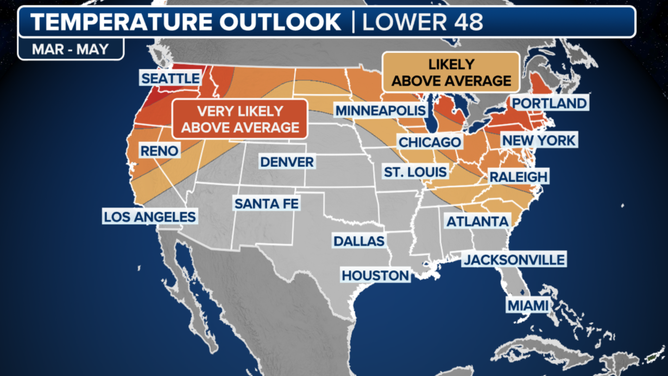Pollen season marches toward peak activity across southern US
Model depictions use data from leaves and first blooms of the cloned lilac cultivar and two cloned honeysuckle cultivars. These species are used because they are usually the first woody plants to bloom and are universally found across much of the country.
Spring allergies and pollen—How to protect yourself
Dr. Gina Coscia of Northwell Health on the best ways to beat sneezing and sniffling this spring.
As FOX Weather warned about in January, the spring growing season is well underway for communities from coast to coast, with some regions nearing extreme levels of pollen.
Data from the USA National Phenology Network, a consortium of individuals and organizations that collect and share phenology information, show nearly a third of the nation has seen the first signs of spring, where the leaf-out process is well underway.
The network said cities such as Portland, Oregon, and Roswell, New Mexico, are upwards of five days early, but coastal communities in Virginia and the Golden State are nearly two weeks ahead of schedule. In fact, California’s Sacramento Valley, as well as coastal areas of Oregon and Washington, are seeing the earliest spring leaf-out reports on record.

(FOX Weather)
SIGNS OF SPRING BEGIN AROUND NATION WITH SPROUTING LEAVES AND INCREASED POLLEN LEVELS
Model depictions use observational data from leaves and first blooms of the cloned lilac cultivar and two-cloned honeysuckle cultivars. These plants are among the first to leaf out and are also among some of the first to bloom when exiting the winter season.
Where leaf production has been underway for an extended period of time, it is also where pollen levels are high.
Pollen activity along parts of the Gulf Coast, Florida, the Southwest and California ranges upwards of high and even extreme in some communities.
Much of the pollen is created by trees from the juniper, oak and pine families, leading to allergy flare-ups.
Allergy specialists estimate at least 50 million Americans suffer from reactions, with many more who are affected and never adequately diagnosed or treated.

(FOX Weather)
March into spring can be halted by cold spells, but there aren’t any on horizon
Forecast models continue to show above-normal temperatures continuing through early March and likely beyond for a large part of the Lower 48.
NOAA forecasters warn the early spring-like warmth could send temperatures anywhere from 15-30 degrees above average.
Without a substantial snowpack in place, chances for a significant arctic air outbreak are reduced as the ground snow cover typically acts as a conveyor belt for delivering cold air southward.
WHAT SEASON DO FRUITS AND VEGETABLES GROW IN?

NOAA Spring forecast
(NOAA)
According to botanists, there has been a steady march towards earlier spring events, such as the leaf-out process and the pollen season.
According to a study published in the Proceedings of the National Academy of Sciences, pollination is occurring nearly three weeks earlier than during the 1990s and is more severe.
"Our results reveal that anthropogenic climate change has already exacerbated pollen seasons in the past three decades with attendant deleterious effects on respiratory health," study authors wrote.
The USA National Phenology Network has made it easy to determine how your community’s leaf-out process compares to previous years. Users can search data by zip codes to determine how far ahead or behind the growing season is compared to normal.
